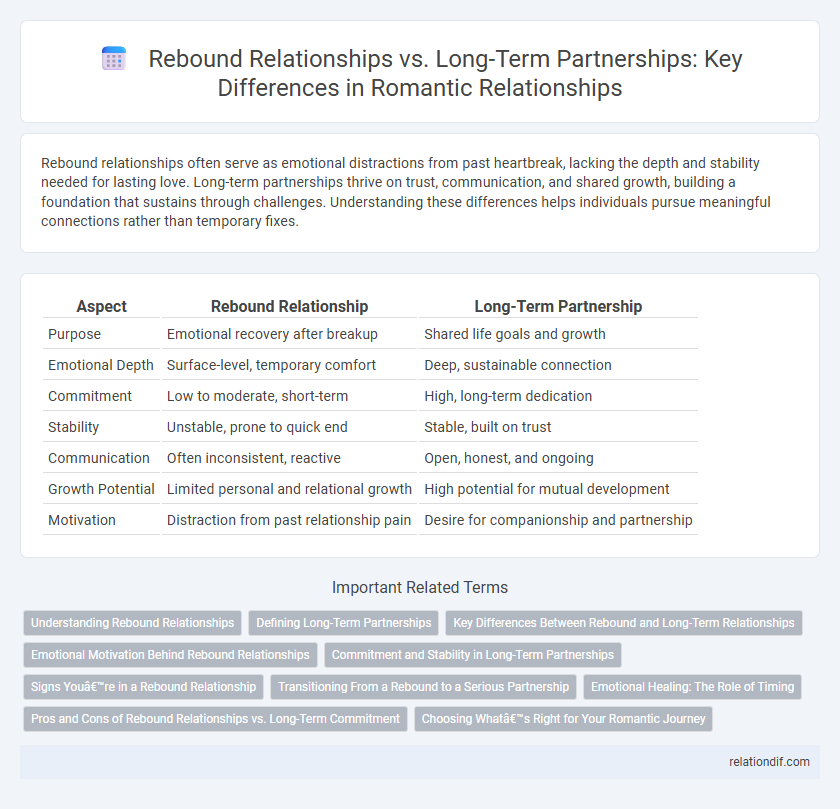Rebound relationships often serve as emotional distractions from past heartbreak, lacking the depth and stability needed for lasting love. Long-term partnerships thrive on trust, communication, and shared growth, building a foundation that sustains through challenges. Understanding these differences helps individuals pursue meaningful connections rather than temporary fixes.
Table of Comparison
| Aspect | Rebound Relationship | Long-Term Partnership |
|---|---|---|
| Purpose | Emotional recovery after breakup | Shared life goals and growth |
| Emotional Depth | Surface-level, temporary comfort | Deep, sustainable connection |
| Commitment | Low to moderate, short-term | High, long-term dedication |
| Stability | Unstable, prone to quick end | Stable, built on trust |
| Communication | Often inconsistent, reactive | Open, honest, and ongoing |
| Growth Potential | Limited personal and relational growth | High potential for mutual development |
| Motivation | Distraction from past relationship pain | Desire for companionship and partnership |
Understanding Rebound Relationships
Rebound relationships often serve as emotional bandages following a breakup, characterized by their short duration and lack of deep emotional connection. These relationships typically provide temporary comfort but rarely build the trust and intimacy necessary for a long-term partnership. Recognizing the signs of a rebound relationship, such as rushing into commitment or using a new partner to avoid loneliness, can help individuals make healthier romantic choices.
Defining Long-Term Partnerships
Long-term partnerships involve deep emotional commitment, mutual trust, and shared life goals, distinguishing them from rebound relationships typically driven by immediate emotional needs. These relationships prioritize consistent communication, growth, and stability over time, fostering a resilient bond between partners. Long-term partnerships often support personal development and provide a foundation for building a future together.
Key Differences Between Rebound and Long-Term Relationships
Rebound relationships often form shortly after a breakup, characterized by emotional vulnerability and a desire for immediate comfort rather than deep connection, whereas long-term partnerships are built on trust, commitment, and shared growth over time. Emotional stability in long-term relationships contrasts with the temporary, often tumultuous nature of rebound romances, which may lack clear boundaries and future planning. Communication patterns in lasting partnerships emphasize mutual understanding and conflict resolution, while rebound relationships may rely more on escapism and short-term validation.
Emotional Motivation Behind Rebound Relationships
Rebound relationships often stem from an urgent emotional need to heal from recent heartbreak, serving as a coping mechanism to alleviate feelings of loneliness and rejection. Unlike long-term partnerships built on deep mutual trust and stability, rebounds prioritize distraction and immediate emotional gratification. Understanding the emotional motivation behind rebounds highlights the temporary nature of these connections compared to the enduring commitment in stable relationships.
Commitment and Stability in Long-Term Partnerships
Long-term partnerships offer deep commitment and emotional stability, fostering trust and mutual growth over time. Rebound relationships often lack this foundation, driven more by immediate emotional needs than sustained connection. Commitment in long-term partnerships supports resilience through challenges and enhances overall relationship satisfaction.
Signs You’re in a Rebound Relationship
Frequent comparisons to an ex and intense emotional highs followed by sudden crashes often indicate a rebound relationship rather than a stable long-term partnership. Signs include relying on the new partner mainly for distraction, feeling unresolved emotions from the past, and rushing the relationship without building a solid foundation. Understanding these patterns helps distinguish temporary emotional recovery from genuine romantic growth.
Transitioning From a Rebound to a Serious Partnership
Transitioning from a rebound relationship to a long-term partnership requires emotional healing and clear communication to build trust and intimacy. Establishing shared goals and understanding each other's needs helps transform transient emotions into a stable foundation. Consistent effort in nurturing emotional maturity and mutual respect paves the way for a committed, enduring romance.
Emotional Healing: The Role of Timing
Emotional healing after a breakup plays a critical role in determining the success of rebound relationships versus long-term partnerships, as rushing into a new romance can hinder genuine recovery and self-reflection. Research shows that individuals who allow sufficient time for emotional processing before engaging in a new relationship tend to experience deeper intimacy and stability. Timing influences attachment patterns, making patience essential for cultivating trust and lasting bonds in long-term romantic connections.
Pros and Cons of Rebound Relationships vs. Long-Term Commitment
Rebound relationships offer a quick emotional recovery by filling the void after a breakup but often lack stability and deep connection, increasing the risk of unresolved feelings and impulsive decisions. Long-term partnerships provide emotional security, trust, and personal growth through shared experiences but require substantial time, effort, and vulnerability to maintain. Choosing between rebound relationships and long-term commitments depends on individual healing needs and relationship goals, where rebounds may serve as a temporary coping mechanism while long-term bonds foster sustained intimacy and mutual support.
Choosing What’s Right for Your Romantic Journey
Rebound relationships often emerge quickly after a breakup, providing short-term emotional support but lacking deep compatibility and long-term potential. Long-term partnerships require commitment, mutual growth, and emotional stability, fostering a foundation for lasting love and shared goals. Choosing the right path depends on self-awareness, readiness for intimacy, and aligning relationship goals with personal growth and happiness.
Rebound Relationship vs Long-Term Partnership Infographic

 relationdif.com
relationdif.com